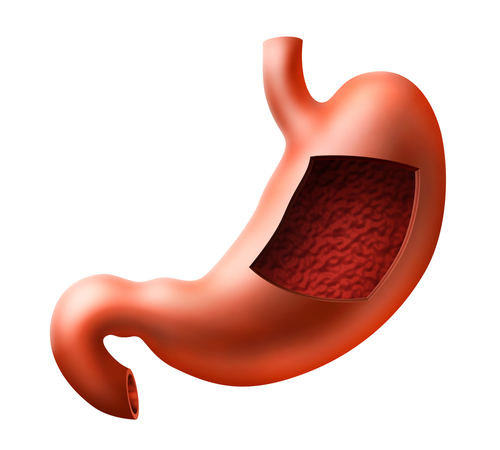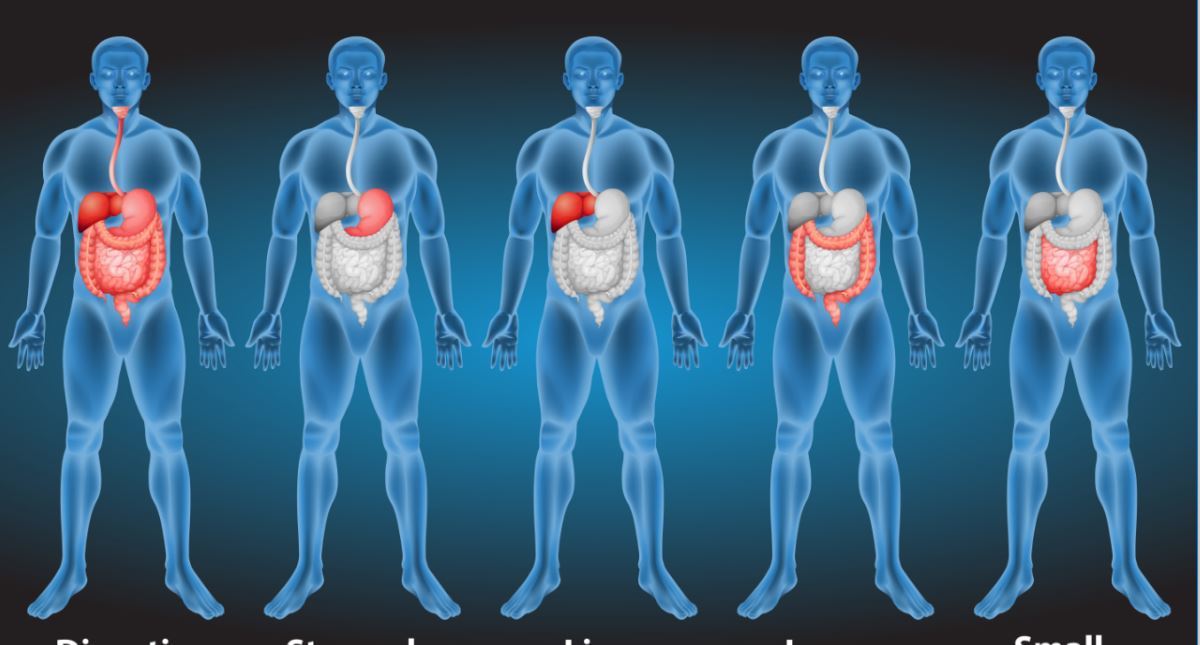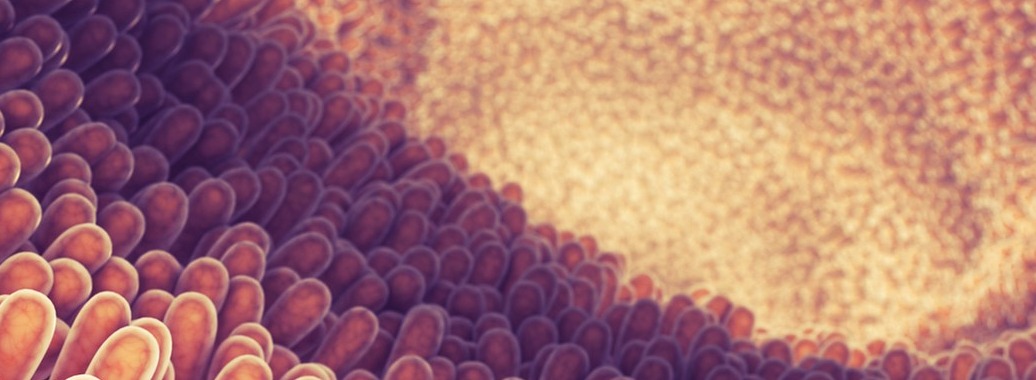6. The digestive system
Contents of the chapter
6.1 Nutrients from food
A. Energy yielding nutrients
 1. Fats
1. Fats- Saturated fats (trans fat, usually animal fat).
- Unsaturated fats (fish and vegetable fat).
- Monosaccharides (glucose and fructose).
- Disaccharides (e.g. cane sugar, milk sugar).
- Polysaccharides (e.g. starch, muscle glycogen).
- Fibers (unabsorbed).
- Plant proteins.
- Animal proteins.
B. Protective foods
1. Vitamins- Fat soluble (vitamins A, D, E and K).
- Water soluble (vitamins B and C).
- Calcium, magnesium, iron, iodine, zinc, selenium.
In addition to nutrients and protective foods, the human body also requires two litres of water every day.
6.2 Digestion
Most people get their daily energy from carbohydrates. We gain a lot of carbohydrates from foods like cereals and potatoes. However, the food we eat must be broken down before the body can take advantage of it. When carbohydrates are broken down, they become sugars. The small intestine carries out most of the digestive processes by using enzymes that work together with enzymes produced in the liver and the pancreas. The enzymes help to break down the food into a form that can be used by our cells as an energy source.

Body's energy consumption at rest. Brains need a great deal of energy at all times.
In addition to energy, we need building materials, especially for the development and maintenance of our skeletal and muscular systems. Proteins are the most important group of such building materials. They are broken down into amino acids, which the human body uses to grow and to repair itself. Protein digestion occurs in the stomach and the small intestine.
Fats are the third major nutrient group. Digestion of fats takes place in the small intestine. The digestion of fats is helped by bile produced in the liver. Bile breaks the fat into small droplets that are easier for enzymes to work on.

Parts of the digistive system.
6.3 Digestion begins in the mouth
Chewing food carefully is important in order for the digestive system to function properly. Saliva, which contains amylase, is excreted in the mouth while you chew food. Amylase is an enzyme that begins to break down carbohydrates. The longer the food is chewed in the mouth, the more amylase is produced. For example, if you keep a piece of sourdough bread in your mouth for a long time, you will notice that it starts to taste sweet. When this happens, the amylase has chopped the bread up into smaller carbohydrates that taste sweeter than the original, larger carbohydrates did.
The function of the esophagus is to transport food and fluid from the mouth to the stomach. At the same time, the epiglottis flips down to prevent food from entering the trachea.
The series of illustrations below displays the swallowing reflex. In the first image, the epiglottis allows air to flow into the trachea. In the second image, the epiglottis flips down. In the final image, the food is swallowed and the air enters the trachea again.
Food passes through the esophagus in a few seconds. The walls of the esophagus contain smooth muscle tissue that carries food downward by contracting. Sometimes you can feel how poorly chewed or dry pieces of food can get stuck in your esophagus. When you rinse the esophagus by drinking liquid, you will feel the liquid level inside your esophagus rise. The nasty feeling eases as the stuck food passes forward into the stomach.
 Swallowing is a reflex.
Swallowing is a reflex.
6.4 The stomach
 The walls of your stomach are strong and muscular. When food reaches the stomach, these walls begin to mechanically mix the food and liquid with digestive stomach juices. The food is heated or allowed to cool down until it reaches a temperature of approximately 37 degrees.
The walls of your stomach are strong and muscular. When food reaches the stomach, these walls begin to mechanically mix the food and liquid with digestive stomach juices. The food is heated or allowed to cool down until it reaches a temperature of approximately 37 degrees.
Pepsin secreted from the mucosa is an enzyme that breaks down proteins. It requires heat and acidic conditions in our bodies. The stomach also contains hydrochloric acid, which creates an acidic environment. Only proteins are digested in the stomach, because amylase secreted in the mouth cannot function under acidic conditions. Fats are also not yet broken in the stomach. The food stays in the stomach from one to four hours.
The digestion of meat and fats in the digestive tract takes up the most time, as these foods remain in the stomach for the longest time. In contrast, carbohydrates are digested quickly. The stomach also serves as a food container, because it only allows small portions of food to pass through to the small intestine at a time.
6.5 The small intestine
The small intestine is about the same thickness as a human finger. It is about four meters long. Its walls resemble a vacuum hose turned inside out, as its inner walls are corrugated. The folds have tiny villi, each of which contains both blood vessels and lymphatic vessels.
Spread open, the small intestine area would cover a tennis court. All sections of the small intestine retrieve digested parts of food, so that all the useful substances you eat are absorbed into the body.
 Villi of the small intestine.
Villi of the small intestine.
The chyme (partly digested food) is transferred from the stomach to the duodenum, the beginning of the small intestine, in small portions. There, bile and pancreatic enzymes are excreted and mixed with the chyme. In addition, the small intestine secretes nutrient-degrading intestinal fluid.
All nutrients are digested in the small intestine. Carbohydrates are broken down by pancreatic amylase into small carbohydrates or sugars.
Pancreatic enzymes break proteins into amino acids. Fats are digested into fatty acids and glycerol with the help of bile produced by the liver and the intestinal fluid secreted by pancreas.
Amino acids and sugars are transported to the liver and therein into the bloodstream through the capillary veins ofthe villi. Fat degradation products are absorbed into the lymphatic system. The final stage of digestion in the small intestine takes from one to four hours. The undigested material is transported to the large intestine.
6.6 The large intestine
All the material that is unabsorbed by the small intestine passes to the large intestine, also known as the colon. The beginning of the large intestine is the caecum (pictured on the left, in your body on the right). The appendix is a small, extended part of the caecum. It used to be considered a vestigial organ, but it actually fulfills some important fuctions, such as retaining beneficial bacteria.
Only the undigested, fluid-rich remains of the food we eat pass on to the large intestine. This substance is called loose feces. It is puzzling that it is here, in the large intestine, where our body's beneficial bacteria produce the vitamins K and B. These vitamins are absorbed into the body alongside fluid when the colon produces solid feces. This process can last from ten hours to several days.
The lower end of your large intestine, the rectum, stores stool until it pushes it out of your anus during bowel movements.


